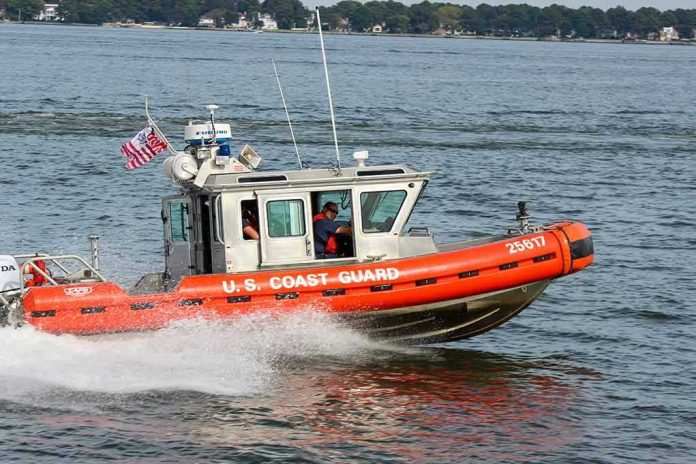
A cyber warfare expert—rather than a traditional mariner—now stands poised to command the U.S. Coast Guard, signaling a digital revolution at the helm of America’s oldest continuous seagoing service.
Story Snapshot
- President Trump nominates Admiral Kevin Lunday, a cyber operations specialist, as Coast Guard Commandant.
- Nomination marks the first time a recognized cyber expert is tapped for the service’s top post.
- Leadership overhaul coincides with Force Design 2028, a sweeping modernization and downsizing campaign.
- Move sparks debate on digital priorities, institutional memory, and the future of maritime security.
Trump’s Disruptive Choice: Cyber Expertise Over Tradition
President Trump’s decision to nominate Admiral Kevin Lunday, a leader known for his cyber operations acumen, as Commandant of the U.S. Coast Guard, shatters decades of precedent. Previous leaders rose through the ranks on the strength of maritime patrols, search and rescue missions, and operational command at sea. Lunday’s nomination pivots the service toward a battlefield invisible to most Americans—one where malware, ransomware, and digital espionage pose as great a threat to maritime security as pirates or smugglers ever did.
The context for this nomination is Force Design 2028, a sweeping reform that reduces bureaucracy, shrinks the number of flag officers by 25%, and realigns leadership roles to prioritize digital defense and organizational agility. Secretary of Homeland Security Kristi Noem unveiled this initiative and the nomination at the Coast Guard Academy’s 2025 commencement, signaling to every graduate—and the entire nation—that the Coast Guard’s future is digital.
Force Design 2028: Rewiring the Coast Guard’s DNA
Force Design 2028 is not mere bureaucratic tinkering; it is a top-down reengineering of the Coast Guard’s operational DNA. Secretary Noem’s announcement that the 2025 rear admiral promotion board was disapproved, and that sweeping new flag assignments are imminent, underscores the scale of this shake-up. Senior officers accustomed to traditional command trajectories now face a hard pivot: digital competence is no longer a niche skill, but a prerequisite for advancement. By reducing the number of flag officers, the administration aims to flatten the hierarchy, speed up decision-making, and focus resources on emerging cyber and homeland security threats.
@USCG Acting Commandant Adm. Kevin Lunday: “The timing of this investment underscores the Coast Guard’s vital need to modernize its command and control capabilities to meet today’s rapidly evolving operational demands. As maritime activity increases and national security…
— Homeland Security (@DHSgov) October 20, 2025
The Coast Guard’s pivot mirrors a broader recognition across all branches of government and industry: maritime infrastructure is now as vulnerable to cyber attack as it is to physical sabotage. Ports, shipping lanes, and even navigation systems can be crippled by bad actors wielding nothing more than a laptop and an internet connection. The Lunday nomination, therefore, is not only about leadership—it is about survival in the digital age.
Winners, Losers, and the New Power Structure
The leadership overhaul has both clear winners and casualties. Admiral Lunday, already serving as Acting Commandant, is the face of the Coast Guard’s new digital ethos. Other senior officers—Thomas Allan, Nathan Moore, Jo-Ann Burdian, Joseph Buzzella, and Douglas Schofield—are reassigned to newly created or reorganized roles, their fates intertwined with Force Design 2028’s priorities. The 25% cut in flag positions means that some careers will end abruptly, and the traditionalists who once governed the service may see their influence wane.
For the thousands of Coast Guard personnel watching from below, the message is unmistakable: digital skills are the currency of the future. The administration’s willingness to upend established hierarchies in favor of cyber expertise is a calculated risk. Supporters hail the move as long overdue, arguing that the Coast Guard must adapt or become obsolete in the face of relentless cyber threats. Critics warn that such rapid change could damage morale and erode the deep institutional memory that keeps the service steady through storms both literal and figurative.
Cyber Frontiers: The Stakes for America’s Maritime Security
The implications of this shift ripple far beyond the service itself. U.S. maritime industries and critical infrastructure operators now have a direct stake in the Coast Guard’s digital transformation. Robust cyber defense is no longer optional for ports, pipelines, and shipping firms; it is existential. The Coast Guard’s new leadership may forge stronger partnerships with industry, set higher standards for digital resilience, and drive new investments in cyber training and technology.
Politically, the administration’s move is a clear signal: the Trump White House intends to be remembered for modernization, efficiency, and digital transformation. The reduction in top brass could mean cost savings, but it also serves as a message to all federal agencies—adapt to the digital age or risk irrelevance. The Coast Guard, with its dual military and law enforcement roles, is now a test case for how legacy institutions can reinvent themselves for the threats of tomorrow.
Sources:
The American Waterways Operators













